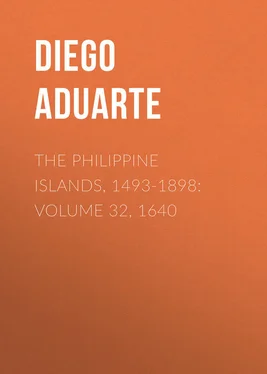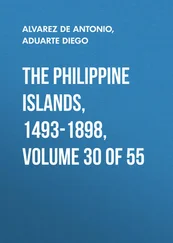Diego Aduarte - The Philippine Islands, 1493-1898 - Volume 32, 1640
Здесь есть возможность читать онлайн «Diego Aduarte - The Philippine Islands, 1493-1898 - Volume 32, 1640» — ознакомительный отрывок электронной книги совершенно бесплатно, а после прочтения отрывка купить полную версию. В некоторых случаях можно слушать аудио, скачать через торрент в формате fb2 и присутствует краткое содержание. Жанр: foreign_antique, foreign_prose, Историческая проза, на английском языке. Описание произведения, (предисловие) а так же отзывы посетителей доступны на портале библиотеки ЛибКат.
- Название:The Philippine Islands, 1493-1898: Volume 32, 1640
- Автор:
- Жанр:
- Год:неизвестен
- ISBN:нет данных
- Рейтинг книги:4 / 5. Голосов: 1
-
Избранное:Добавить в избранное
- Отзывы:
-
Ваша оценка:
- 80
- 1
- 2
- 3
- 4
- 5
The Philippine Islands, 1493-1898: Volume 32, 1640: краткое содержание, описание и аннотация
Предлагаем к чтению аннотацию, описание, краткое содержание или предисловие (зависит от того, что написал сам автор книги «The Philippine Islands, 1493-1898: Volume 32, 1640»). Если вы не нашли необходимую информацию о книге — напишите в комментариях, мы постараемся отыскать её.
The Philippine Islands, 1493-1898: Volume 32, 1640 — читать онлайн ознакомительный отрывок
Ниже представлен текст книги, разбитый по страницам. Система сохранения места последней прочитанной страницы, позволяет с удобством читать онлайн бесплатно книгу «The Philippine Islands, 1493-1898: Volume 32, 1640», без необходимости каждый раз заново искать на чём Вы остановились. Поставьте закладку, и сможете в любой момент перейти на страницу, на которой закончили чтение.
Интервал:
Закладка:
The Philippine Islands, 1493-1898: Volume 32, 1640 Explorations by early navigators, descriptions of the islands and their peoples, their history and records of the Catholic missions, as related in contemporaneous books and manuscripts, showing the political, economic, commercial and religious conditions of those islands from their earliest relations with European nations to the close of the nineteenth century
Preface
In the present volume is concluded the excellent Historia of the Dominican writer Diego Aduarte, begun in Vol. XXX, and continued in XXXI; the period of mission history here covered being 1608–37. Aduarte died in 1636; but the events subsequent to 1634, with a sketch of Aduarte’s life, are added by the hand of his editor, Fray Domingo Gonçalez.
Continuing the life of Fray Luis Gandullo, who was prominent among the founders of the Dominican province, Aduarte narrates the marvelous conversions and even miracles wrought by him, and many of his visions and other wonderful experiences. In 1612, the chapter again elects Fray Miguel de San Jacinto as provincial. The persecutions in Japan become more widespread and severe; various incidents therein are related. Our writer sketches the life of Fray Diego de Soria, the second bishop of Nueva Segovia; and of another early missionary in that province, Francisco Minayo.
Book ii of Aduarte’s history recounts events from 1614 on, beginning with Japan, where a new and more cruel persecution of the Christians begins with that year; and orders are given by the shogun that all priests and religious must be banished from Japan. When this order is carried out, many of the missionaries remain in the country, in hiding and disguised – traveling through the country to instruct and console the Christians, suffering great hardships and dangers, and finally, in most cases, dying as martyrs for their faith. In the long biography of Fray Francisco de San Joseph Blancas, the most interesting point is his linguistic achievements in the Tagal language, and the introduction of printing in the Philippine Islands, which Aduarte here ascribes entirely to Fray Francisco. This father also learned the Chinese language, and assumed the charge of instructing the negroes and slaves in Manila.
In 1615, the Cagayán mission is much disturbed and injured by the flight to the mountains of many Indians who had been gathered into the mission reductions; this is caused by the machinations of the aniteras, or priestesses of the old idols, who try to draw these half-tamed Indians back to their old superstitions. In this year come a large company of religious; and in 1616 the provincial elected is Fray Bernardo de Sancta Catalina – who dies soon afterward, and of whom Aduarte writes a long biographical account. He is succeeded as provincial (April 15, 1617) by Fray Melchior de Mançano. The persecutions in Japan steadily increase in severity, in 1615–16, in which latter year Iyeyasu dies. In 1617 two missionaries – one a Dominican, the other an Augustinian – deliberately go to Omura to rebuke the daimiô for his cruelty to the Christians, and to preach the gospel in public; they, with other captive religious, are put to death. Their example in so bravely enduring martyrdom encourages and strengthens the Japanese Christians, many of whom give their lives for the faith, and compels the respect of the heathen. Other missionaries are arrested, and suffer great privations while in prison.
Aduarte recounts the progress of the work undertaken by the Dominicans for the Chinese in Manila. For many years the missionaries live at Binondoc, the village to which the Christian Chinese go to live when they receive the new faith; but they conclude that it would be better for all concerned to build a convent and church within the Parián. In 1617 they begin to erect these buildings, and priests of the order take up their residence therein, in the midst of that great market and its crowd of traders and artisans. Their labors are crowned with notable and prompt success – not only in securing the baptism of the sick and dying, but in the instruction of those who are in health, who carry the gospel into their own country, wherein the missionaries hope to effect a great conversion some day. The church first erected is a poor and unsubstantial affair; but afterward a large and very handsome church is built – in the Chinese fashion, of wood shaped and fitted without any nails. When the Parián is burned in 1628, the church is saved by placing an image of the Virgin in front of the approaching flames. Later, the timbers begin to decay, and another building is erected, with stone pillars; its walls are covered with paintings, which serve greatly for the instruction of the heathen. During fifteen years, the number of baptisms in this church amounts to 4,752. The Dominicans win the great respect and affection of the Chinese, who seldom die without having received baptism.
This order extends its labors to some other countries. China is, of course, the chief goal of its desires; but the Dominicans are unable to effect an entrance therein. One of the friars, attempting to go there (1618), is obliged by storms to land on Formosa; and to his subsequent report of the advantages of this island is ascribed its later acquisition by the Spaniards. Another mission sets out for Korea, but is unable to go farther than Nangasaki, and is thus frustrated. Twenty-four new missionaries arrive this year from Spain. A new residence is established at Cavite, the priests in which accomplish much good, among both Spaniards and natives. A new mission is begun in the Babuyan Islands, north of Cagayán; it is very arduous and full of privations, but the religious gladly labor therein, and find the people excellent Christians, although they are most poor and needy. The fathers often ask alms from the convents and the Christians in Nueva Segovia, to help these poor disciples of the Lord. Some of the religious who have remained in Japan are martyred in this year of 1618; yet amid the fierce persecutions new converts are made, and the native Christians show much loyalty and generosity to their spiritual fathers.
In 1619 the intermediate chapter session meets at Nueva Segovia, on which occasion the college of Santo Thomas at Manila is formally added to the province; an historical sketch of this institution is presented. In November of that year occurs an unusually severe earthquake in Luzón, of which various features and incidents are recorded. Among the buildings overthrown is the Dominican convent in Manila, all its inmates, however, escaping in safety. In 1621 Fray Miguel Ruiz is elected provincial. On November 6 of that year occurs a revolt among the Gadanes in northern Luzón, of which a full account is given. One of the Dominican missionaries, Fray Pedro de Santo Thomas, courageously goes alone and unarmed, to the mountain stronghold of the insurgents, to win them back; and some months later he returns with three hundred families of these rebels, who settle peaceably on the lower lands. Aduarte fills chapters xviii–xxvi with accounts of martyrdoms of Dominicans in Japan, during 1621–23, and sketches of their lives – matter which is presented to our readers in brief synopsis, as but indirectly concerning the Philippines.
The election of provincial in 1625 elevates to that dignity Fray Bartholomé Martinez, who has long labored among the Chinese of Manila. In this year occurs another revolt among some of the Cagayán Indians; two religious are treacherously slain by them, and then they flee to the mountains. In 1626, Fernando de Silva sends an expedition to conquer Formosa, which is accompanied by Dominican missionaries, who hope to find in Formosa a stepping-stone to an entrance for them into China. A fortified post is established in the island by the Spaniards; the Dominicans act as spiritual guides for the soldiers, and, after learning the native language, are able to win the confidence of the inhabitants and begin instructing them. Many of the missionaries in the province die, but a reënforcement comes to them in this same year. In 1627 is held the intermediate chapter-session. By that time the revolted Mandayas have been pacified, and by the efforts of their Dominican pastors induced to return to their villages and to the care of the missionaries. In this year occur many martyrdoms in Japan, of which accounts are given. In 1628, the four orders of friars in the Philippines unite to send a reënforcement of missionaries to Japan, but this attempt is frustrated by the wreck of their ship. Aduarte at this time arrives at Manila with a large company of religious. A Spanish expedition is sent to Camboja, and the Dominicans send missionaries thither; but both enterprises result in failure. In Formosa they are making some progress.
Читать дальшеИнтервал:
Закладка:
Похожие книги на «The Philippine Islands, 1493-1898: Volume 32, 1640»
Представляем Вашему вниманию похожие книги на «The Philippine Islands, 1493-1898: Volume 32, 1640» списком для выбора. Мы отобрали схожую по названию и смыслу литературу в надежде предоставить читателям больше вариантов отыскать новые, интересные, ещё непрочитанные произведения.
Обсуждение, отзывы о книге «The Philippine Islands, 1493-1898: Volume 32, 1640» и просто собственные мнения читателей. Оставьте ваши комментарии, напишите, что Вы думаете о произведении, его смысле или главных героях. Укажите что конкретно понравилось, а что нет, и почему Вы так считаете.












